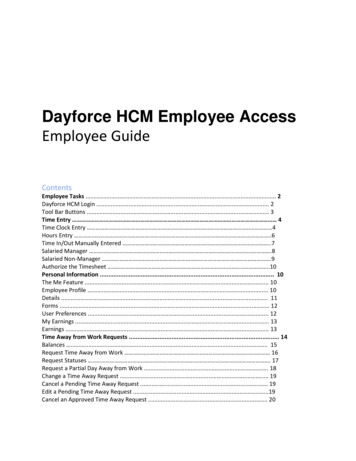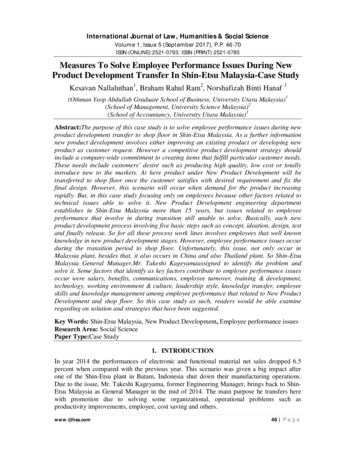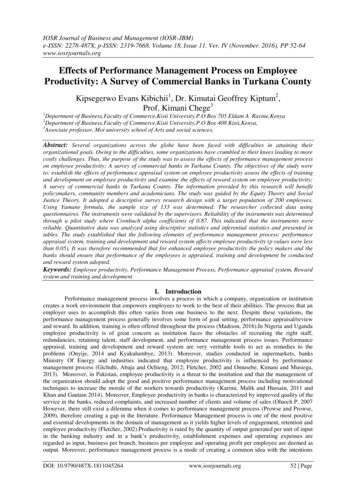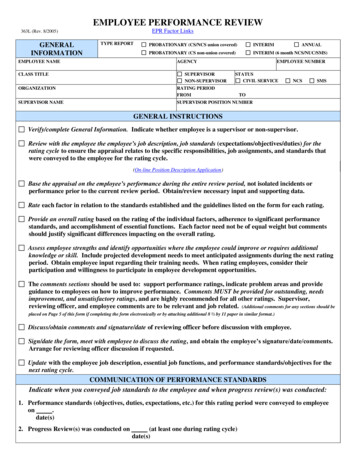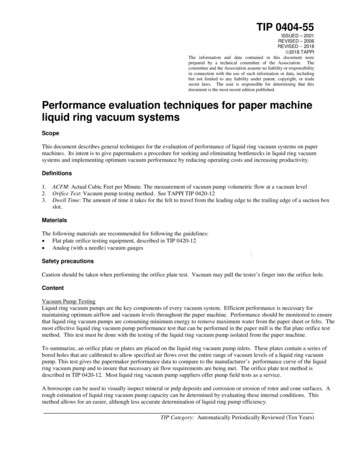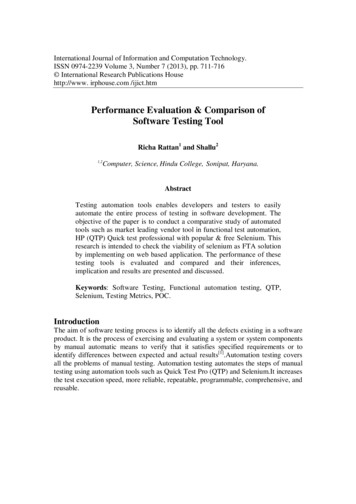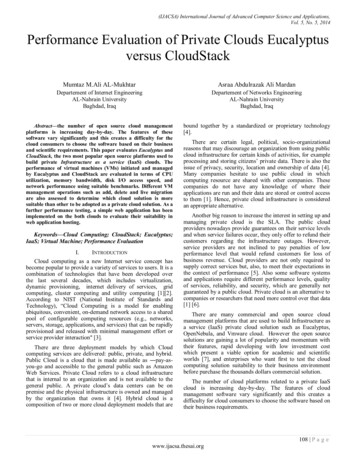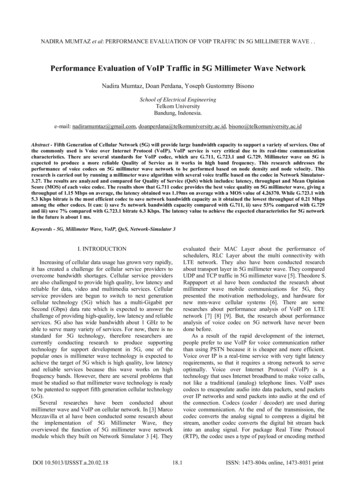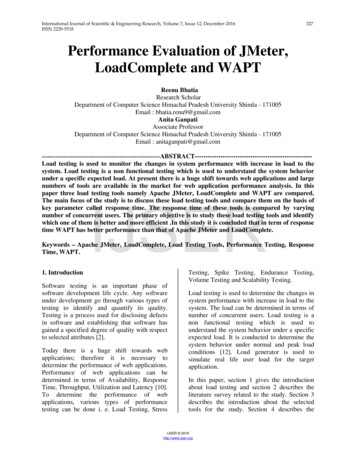
Transcription
EMPLOYEE PERFORMANCEFor Exempt and NonexemptEVALUATION Staff and Service PersonnelEmployee’s Name (Last, First, MI):Position Title:Department:Type of Report:Period Covered: From:ProbationaryAnnualOtherEmployee ater (Name, Title) :Reviewer (Name, Title) :N/APART II:BEHAVIORAL TRAITSDependabilityInterpersonal 56789N/A123456789N/A12345789RATING SCALEPART I:PERFORMANCE FACTORSKnowledge, Skills & AbilitiesQuality of WorkQuantity of WorkWork Habits/Time ManagementCommunicationCOMMENTS:NEEDSPOOR IMPROVEMENT6
PART III:SUPERVISORY FACTORSLeadershipDelegationPlanning & OrganizingDeveloping OthersPersonnel EXPECTATIONS45EXCEEDSEXPECTATIONS678SUPERIOR9PART IV:OVERALL PERFORMANCEPART V:NARRATIVE: Discuss significant strengths and areas requiring improvement. All ratings of 1 and 2 in Parts II, III, and IVmust be explained in detail in this section. An overall rating of 8 or 9 in Part V must be supported in this section.(Continuation sheets may be added.)SIGNATURES:Rater:Date:Reviewer:Date:PART VII:To the Employee: The ratings assigned to this performance evaluation represent judgments made by thesupervisor regarding your performance of your responsibilities and duties, work-related behavioral traits andsupervisory factors, if applicable, during the reporting period and will be reviewed by the next higher level supervisorprior to being placed in your permanent personnel file. You may request a meeting with your reviewer to discuss therating. You have a period of 10 business days from the date on which you signed this evaluation to file a writtenappeal if you feel the ratings do not adequately reflect your performance. Policies and procedures for appealing theevaluation are set forth in Paragraph L, Appendix Q, Staff and Service Employees’ Personnel Handbook.I have reviewed this evaluation and have had the opportunity to discuss it with my rater. I understand that Imay appeal this evaluation by following the above-referenced procedures.I agree with this evaluation.I do not agree with this evaluation.Employee’s Signature: Date:
PART V CONTINUED:NARRATIVE: Discuss significant strengths and areas requiring improvement. All ratings of 1 and 2 in Parts II, III, andIV must be explained in detail in this section. An overall rating of 8 or 9 in Part V must be supported in this section.
KNOWLEDGE SKILLS AND ABILITIES:Employee's work product demonstrates an application of the technical knowledge and various skills needed ie:managing computer-based records, familiarity with UPD policies, laws and regulations. Employee keeps abreast ofdevelopments and trends in law enforcement.QUALITY OF WORK: Produces accurate, neat work product. Performs work thoroughly, expresses self well inverbally and in writing.QUANTITY OF WORK: completes work assigned, and on time. manages a variety of tasks and projects.WORK HABITS/TIME MANAGEMENT: Employee develops comprehensive, realistic plans and organizes workassignments to ensure timely completion of quality work products. Manages time well and effectively handles multipledemands and competing priorities. Take initiative in assuming more complex assignments and developmentalactivities. Attends work regularly, and observes work hours.COMMUNICATION: Interacts professionally and courteously with supervisors, coworkers, citizens and others;readily shares information and provides assistance; verbally communicates information in an understandable manner;written communications are consistently clear and accurate; demonstrates understanding of instructions;demonstrates tolerance in working with coworkers, others and with changes in job conditions; demonstratestolerance of differing behaviors, customs and communication styles; understands and works toward group goals andobjectives; encourages and is receptive to new ideas and procedures.DEPENDABILITY: Performs duties willingly. Personal problems do not effect work performance. Acceptssuggestions and follows directions: Considers constructive criticism and makes necessary changes inperformance. Follows directions of supervisor.INTERPERSONAL RELATIONSHIPS: Employee gets along with others and establishes effective relationships toaccomplish work products or service. Demonstrates respect for others, including the community and peers.Demonstrates courtesy and tact when dealing with people. Fully participates as a team member in theaccomplishment of the work product.INITIATIVE: Understands and accepts new situations, performs well with minimal instructions. Makes soundsdecisions in absence of detailed instructions or direct supervision. Keeps supervisor informed on status of assignedwork.ADAPTABILITY: Demonstrates good judgment, makes reasonable decisions, Practices self-control—thinks beforeacting. Employee Analyzes situations accurately and adapts well to change. Performs well in new situations, adjuststo new scheduling and/or changes in schedules, demonstrates willingness to learn new tasks and procedures.Demonstrates willingness to incorporate new ideas or methods.JUDGEMENT: Uses good judgment and a common-sense approach to situations, particularly during stressful situations;requires minimal supervision; determines appropriate course of action and takes same; does not allow situations tofurther deteriorate; recognizes when to ask for assistance; anticipates situations and prepares for them; is capable ofchanging way of thinking and performing in conjunction with the needs of theSUPERVISORY FACTORS: You should evaluate the employee's supervisory abilities as an officer. Indicate wherethe officer actually makes use of these factors. If not applicable, mark N/A. If no leadership qualities apply make notein comments section.LEADERSHIP: Demonstrates the ability to get other people to work together effectively; is able to see the "bigpicture" and articulate how the pieces fit together; takes ownership for own activities; recognizes and appreciatesindividual differences; interacts with others objectively; is able to draw upon his/her own resources in Assessingsituations and taking or recommending appropriate action for resolution.DELEGATION: Assigns responsibility to an employee to complete a task, grants the employee sufficient authority togain the resources to do the task and allows the employee decide how that task will be carried out. Sharesaccountability with the employee for ensuring the task is completed.
PLANNING AND ORGANIZING: Defines expectations and tasks clearly. Plans and organizes work, coordinateswith others, establishes appropriate priorities. Allows sufficient time for completion of assignments. Delegatesauthority when appropriate. Determines appropriate action and follows through in a timely and decisive manner. Iswell organized and uses time productively. Ensures that work products and services consistently meet needs ofcustomers.DEVELOPING OTHERS: Effectively and timely evaluates subordinates; encourages and initiates regular discussionof performance; fosters the learning and development of others through coaching, managing performance, andmentoring.PERSONNEL MANAGEMENT:Brings about an enthusiastic and optimistic attitude in the unit, Rewards and recognizes individual and teamsuccesses. Provides timely information on performance and frequent feedback. Resolves differences and seekswin/win outcomes. Acts forthrightly in response to unacceptable behavior or performance and focuses on thesituation, issue or behavior rather than on the person. Promotes employee safety and wellness. Maintainsappropriate confidentialityOVERALL PERFORMANCE: To arrive at an overall evaluation of the employee’s performance, supervisors considerthe relative importance of each work goal and competency with its relative weight. Moreover, supervisors shouldconsider performance and accomplishment that furthered the goals/objectives of the organization, contributionsabove and beyond completion of basic work assignments and completion of or contribution to special projects.
The ratings assigned to this performance evaluation represent judgments made by the supervisor regarding your performance of your responsibilities and duties, work-related behavioral traits and supervisory factors, if applicable, during the reporting period
